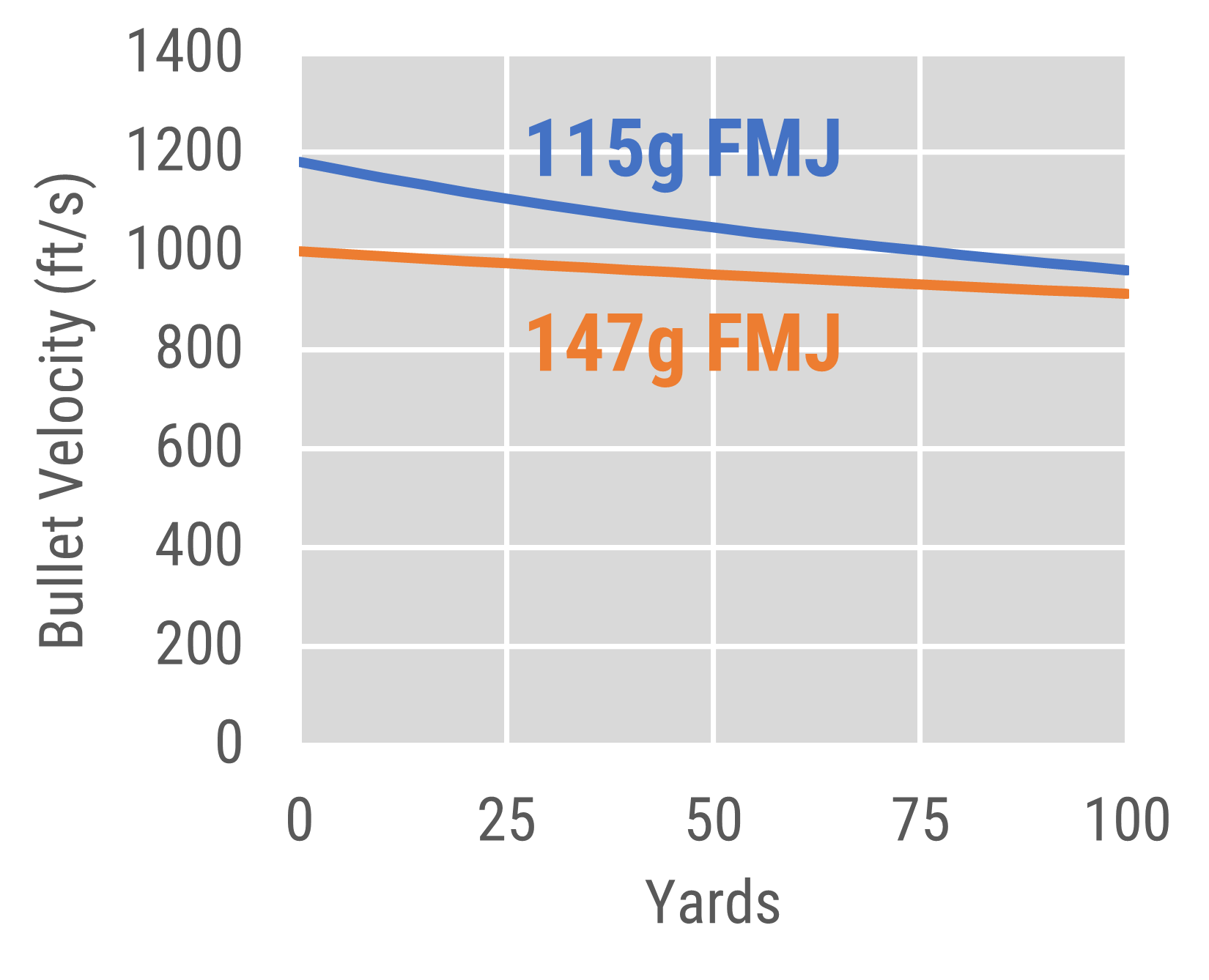9mm Ammo Loads
Within 9mm ammo there are multiple options for weight of the bullet projectile. These weight options are referred to as loads. Loads are measured in ‘grain’ which is a unit of measure equal to 1/7000 of a pound and abbreviated as g. The three common loads for 9mm are 115, 124, and 147 grain. Some specialty rounds are as low as 88 g or high as 158 g. To be clear, grain refers to the bullet weight and not to the amount of gunpowder in the casing. A good benchmark for mental comparison is U.S. pennies. Three coins together weigh 116 grain. Adding a fourth penny brings the total to 154 grain.

Heavier loads travel at lower speeds. Bullet speeds exiting the gun barrel range from 950 to 1400 ft/sec for the various 9mm loads. The graph above shows a comparison of bullet speed for 115 and 147 grain full metal jacket. If muzzle velocity is below the speed of sound (1,126 ft/s) it is called subsonic ammo, which is typical for 9mm ammo that is loaded at or above 147 grain. Subsonic speed will eliminate the supersonic shockwave ‘crack’ that follows a projectile downrange. Though quieter from a distance, a subsonic load creates the same peak noise level for the shooter as compared to supersonic loads.
Load influences the amount and the feel of the gun recoil. A good proxy for the amount of recoil is the ‘power factor’ (aka momentum) of the bullet. Momentum is conserved according to the laws of physics. Therefore, momentum of the bullet exiting the muzzle equals momentum imparted back to the shooter in the opposite direction.
The ‘Power factor’ is used to quantify momentum and is defined as the product of bullet weight in grains, times muzzle velocity in ft/sec, divided by 1000. You can look up manufacturer specs for muzzle velocity for most ammo. For example, compare these two loads for power factor:
- A round of FMJ 115 grain from Federal Premium will achieve a muzzle velocity of 1180 ft/sec. So the power factor is 1180 x 115 / 1000 = 135.7
- A round of FMJ 147 grain from Federal Premium will reach a muzzle velocity of 1000 ft/sec. So the power factor is 1000 x 147 / 1000 = 147
In our example above the heavier bullet has 8% higher power factor (147 > 135.7). The complication is that the bullet momentum is transferred to the shooter at different rates in these two scenarios. Momentum is transferred to the gun during the course of the time it takes for the bullet to accelerate from rest to the point it exits the barrel. This duration is shorter for the faster bullet by about 20%. So the total momentum transfer happens in a shorter time than it does when firing the heavier/slower bullet. Force is the rate at which momentum changes with respect to time. So most people perceive the recoil force of the lighter load to feel ‘snappier’ and the heavier load to feel more like an extended ‘push.’
Shooting bullets with similar power factors will feel nearly the same in recoil. Consider two bullets with the exact same power factor but different weight and speed combinations: the heavier bullet will impart marginally less feeling of recoil due to the longer duration of momentum transfer. In many shooting competitions there is a minimum power factor requirement in order to level the playing field with respect to recoil. Shooters load as close to the minimum limit as possible, tending to favor heavier loads in order to minimize the ‘felt recoil.’
Which load does more damage? Which load penetrates deeper? Which load is most accurate? These depend on a combination of multiple factors including the following:
- bullet shape
- bullet material
- dimensional tolerance variations within a collection of bullets
- gun barrel length
- barrel tolerances
- barrel rifling pattern
- barrel porting if present
- wind speed
- target distance
- target material
Let’s revisit our comparison of the 115 grain load vs. the 147 grain load. Exiting the barrel of the gun, the 115 grain load has ~9% more kinetic energy. After 25 yds out the advantage flips due to air drag and the 147 grain retains slightly more kinetic energy. The following plot shows energy of the bullet vs. distance of its travel in yards.

For a particular gun model in combination with shooting conditions (distance, rain, wind) the load may have a slight effect on accuracy but would not be noticeable for shooters at most skill levels and at most relevant distances.
You will experience less wind drift with heavier loads. If shooting in 30 mph cross wind, a 115 grain FMJ bullet will drift 4.4 inches at 50 yards. The 147 grain load would drift only 2.0 inches under these same conditions.
You can’t go wrong selecting any of the three common 9mm loads (115, 124, 147) for practice or for personal defense. The potential differences in performance and terminal wound capability are almost negligible. The type of 9mm round is by far more important than the load weight. A word of caution: if you go with extremely light or heavy loads outside the range of 115 to 147 you may experience more malfunctions in cycling rounds depending on the design of your gun.
Next Topic: Overpressure Ammmo (+P Ammo)